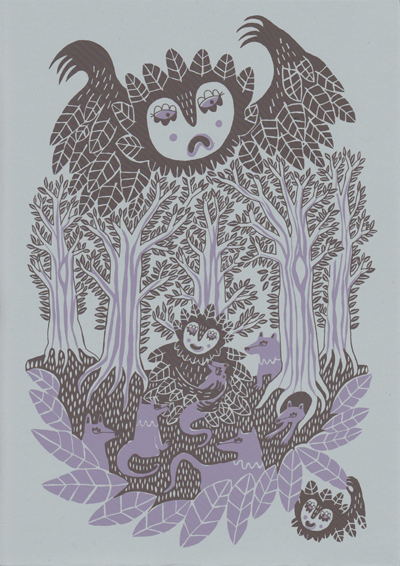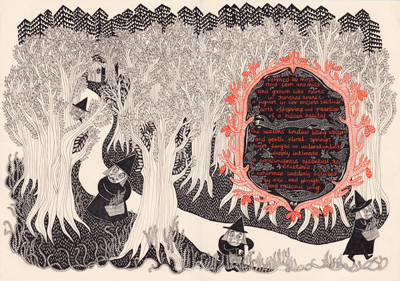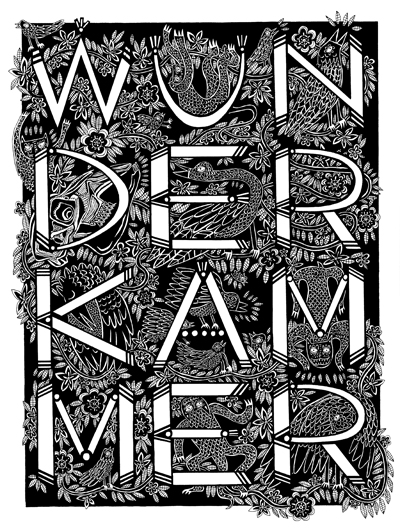Esther McManus is an illustrator, printmaker and a creator of comics, based in London.
Her prints and drawings have a strong sense of narrative, and her stories are inspired by woodlands, folklore, sorcery and dreamscapes.
She is also a technician at Print Club London - a screenprinting studio in Dalston, East London.
As The Sickle Moon Rises, screenprint.
The protagonists of your prints seem to be characters from a fairy tale: forest inhabitants, monsters and witches.
Can you tell us more about your lovely, although sometimes scary, creatures?
A lot of the characters I draw, or think about, are probably based on childhood fears or the kind of things you fear when you are on your own.
There is something about isolation that makes my imagination run riot!
If I am alone I often become scared of things that would seem perfectly benign if I was in the company of others.
I probably feel happiest in the forest, and as a city dweller I find that I am often daydreaming about (and drawing pictures of) the forest.
Innevitably a lot of my stories and drawings end up being situated there!
Thinking about it, I probably live vicariously through the little witch who I draw so much - living in the forest in solitude, building my house in a tiny dell, wearing those awesome black smocks and hats... it is very appealing to me.
I am also really fascinated by the kind of spaces that are created in our dreams - the places that seem familiar to us, yet are altered in some ways.
I like the way that elements from your daily life are filtered and squashed together, presenting you with these disturbing, uncanny stories that you remember upon waking.
It is something that I try and convey when I tell stories - the haphazard narratives of dreams, the merging of everyday objects with your darkest fears, and the way you remember glimpses or feelings - not necessarily the whole thing.
Many of the monsters and forest dwellers are developed in this way - they come from the environments that the characters inhabit.
Bits of everyday things, grass and foliage combine with claws and malicious intentions.
Comics and zines are two of your favourite mediums.
Is telling a story an important part of your creative expression?
Yes, I think so.
I love drawing images for one-off prints, but I would probably think of them as single-panel comics!
I always have a story or narrative that I want to express in a piece of work - the characters will always have relationships or tensions, and I will always be trying to create a specific atmosphere.
I think it is quite important to me to try and convey alternative stories, breaking away from stereotypes using familiar models or characters.
I like working in the grey area between fact and fiction - that area of anecdote, where things are half remembered and half embellished.
I love that aspect of storytelling - where the mundane becomes fantastical. What are your favourite methods of printmaking?
Predominantly, I screenprint - but I also really like linocutting.
There is something about the solidness and simplicity of both that appeals to me - the restrictions, and the problem solving elements.
I do linocuts far less than screenprints, but whenever I do I really like the immediacy and the visibilty of your marks.
I do have such a fondness for screenprinting though - the layering of the image, and the problem solving elements of separating the colours, the diversity of tone you can achieve with play and experimentation, and the control you can have over the ink's colour and transparency... it is magical to me.
And it is right-reading, so you do not need to reverse anything when you make an image!
What is the aspect that you prefer about printing?
As opposed to other ways of producing images?
I love the strong connection with the ink and paper, and the multitude of choices you have.
I like the fact that the process imposes limitations, like the thicknesses of paper you can print on, and the fineness of the mesh.
One of the things that thrills me the most (as opposed to digital printing, especially) is the choice and richness of colours you can use, and the amount of control you have.
You can be very creative with the raw materials, and experiment with different elements of the process, like playing with the layering and building up of your image.
What and/or who influences your prints?
I am massively influenced by the process
itself - the limitations and restrictions are always present when I am
thinking about creating images.
But I suppose at the stage where I am developing ideas, I am influenced by experiences that are fresh in my mind - trips to the forest, things we saw there, encounters with animals and birds.
But I suppose at the stage where I am developing ideas, I am influenced by experiences that are fresh in my mind - trips to the forest, things we saw there, encounters with animals and birds.
My parents have an allotment, and seeing plants grow and bear fruit and vegetables has always been inspiring to me.
The allotment
itself is such a wonderful concept - you have this link to food
production, and natural cycles, that you just would not otherwise (as
people living in a city or the suburbs).
It is very obvious from my work, but I really love learning about the traditions and folklore of a place, and the people who have lived there.
I do not mean in a grand or exotic way - every place has its stories and its traditions.
I guess it returns to being interested in the alternative stories that can be told, and perhaps even an alternative history. How do you think printing will evolve?
I guess the processes are evolving all the time - inks, papers, whatnot.
The technical aspects of these processes, and the products and tools that are now available are changing all the time, especially for things like waterbased inks, and more ethically minded inks, emulsions and cleaning products.
I think you are right - that printing does need to evolve, and be used in different ways, but I think something that makes it strong and enduring is its solid foundation in its craft and tradition.
Screenprinting has such a rich and interesting history, and it carries that with it all the time.
I think the analogue craft processes of printmaking, and the control that you have over your images as a hands-on process make it appealing and special.
From my perspective, as a printer, I revel in the process as it is, and the results that I can achieve.
I think the evolution may be considered in terms of the application of the process - the creative output that is achieved.
I love seeing these processes used to create things that can be produced cheaply and quickly now - handmade and printed books, which are playful and beautiful objects, as opposed to a cheap disposable paperback.
They both have their place and function, but it is the juxtaposition that makes you able to see the value of both.
Can you tell us something about your next printmaking project?
At the moment I am working on a larger scale comic - it has quite an epic page count, and I have been planning and drawing it for quite a while now.
I am producing the images as two-colour screenprints, and have been testing those out more recently.
It has been lovely to work on a larger scale narrative.
I also produce prints and comics with my dear collaborator Adam Ferner, and we have currently been producing screenprinted maps and zines based on walks we have taken in local woodlands.
Again, we have been trying to blur the line between fact/fiction/folklore, and the way that you can use something like a map to show various layers of information and history of a place.
At the moment though, I am trying to focus as much as possible on getting this comic finished!
Forest Guardian, screenprint.
Gravel Man, screenprint.
Moss And Fern And Mist, screenprint.
Nighttime Wanders, screenprint.
Stealin' Baby, screenprinted zine.
Wunderkammer, screenprint.









No comments:
Post a Comment